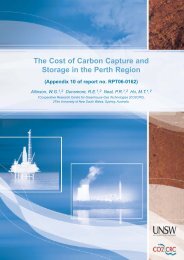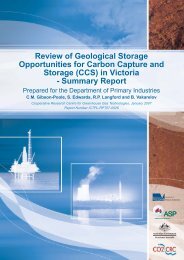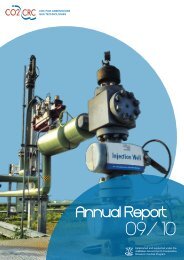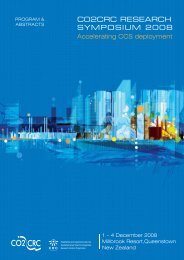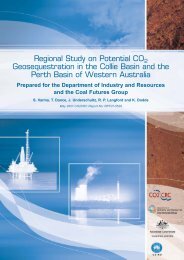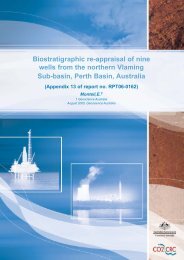Read the full report (PDF27.8 MB) - CO2CRC
Read the full report (PDF27.8 MB) - CO2CRC
Read the full report (PDF27.8 MB) - CO2CRC
Create successful ePaper yourself
Turn your PDF publications into a flip-book with our unique Google optimized e-Paper software.
6. Southwest Bowen Basin Study Area - Wunger<br />
Ridge Flank<br />
6.1. Seismic Interpretation<br />
6.1.1. Previous Work and Structural Framework<br />
A regional interpretation of <strong>the</strong> Bowen Basin was carried out in <strong>the</strong> 1990’s by <strong>the</strong> <strong>the</strong>n Bureau of<br />
Mineral Resources, now Geoscience Australia, in conjunction with what is now <strong>the</strong> Queensland<br />
Department of Natural Resources, Mines and Energy (QDNRME). The interpretation used regional<br />
seismic lines tied to a regional array of wells as well as deep crustal transects. Significantly more<br />
seismic data existed locally within <strong>the</strong> Wunger Ridge flank study area than were utilised in <strong>the</strong><br />
regional studies, so that fault trends and maps of individual horizons interpreted by <strong>the</strong> Bureau of<br />
Mineral Resources (data and interpretation available from Geoscience Australia) were considered<br />
too generalised for <strong>the</strong> purpose of this study. All available seismic data within <strong>the</strong> Wunger Ridge<br />
flank study area (Figure 2.2c) were thus used so as to produce a more detailed interpretation.<br />
This section presents interpretive results: detailed geophysical reviews are summarised in<br />
(Appendix 10.6.6.).<br />
Previous regional interpretations included those carried out at a sequence stratigraphy level (Brakel<br />
et al., in press); deep crustal transect level (Korsch et al., 1992) and at a regional structural and<br />
exploration level (Korsch et al., 1998; Shaw et al., 1999).<br />
Key tectono-history summaries contained in <strong>the</strong> above references, and pertinent to <strong>the</strong> study area,<br />
are summarised below.<br />
• A late Carboniferous to Early Permian extensional or rift phase is recognised in <strong>the</strong> Bowen<br />
Basin from <strong>the</strong> presence of large-scale half grabens and associated extrusion of volcanic<br />
rocks (Korsch et al., 1992). Large scale faults imaged on deep crustal transects were not<br />
observed on <strong>the</strong> shallow seismic data used in this study.<br />
• During <strong>the</strong> Permian, <strong>the</strong> rift phase and subsequent <strong>the</strong>rmal subsidence phase switched to a<br />
compressional regime associated with east-to-west thrust belts. These thrusts were imaged<br />
on deep crustal transects and observed in outcrop geology (Korsch et al., 1992). Foreland<br />
loading from <strong>the</strong> east during <strong>the</strong> late Permian to mid Triassic produced significant downwarping<br />
of <strong>the</strong> Taroom Trough (Figure 3.5): <strong>the</strong> Trough received significant sedimentation<br />
from <strong>the</strong> east resulting in <strong>the</strong> deposition of <strong>the</strong> Rewan Formation. It is interpreted that downwarping<br />
of <strong>the</strong> Taroom Trough in <strong>the</strong> east may have caused some degree of flexure in <strong>the</strong><br />
west, probably resulting in relatively low accommodation space in <strong>the</strong> west Bowen Basin.<br />
• The final Bowen Basin phase in <strong>the</strong> mid–late Triassic was one of uplift and erosion, forming<br />
<strong>the</strong> unconformable boundary between <strong>the</strong> Bowen and <strong>the</strong> overlying Surat Basin.<br />
6.1.2. Time Interpretation<br />
Seismic horizons<br />
Six seismic horizons were interpreted within <strong>the</strong> study area, and an additional two horizons were<br />
phantomed (copied from an already interpreted horizon and shifted in time (Table 6.1).<br />
For example, <strong>the</strong> Showgrounds Sandstone was phantomed down from <strong>the</strong> Snake Creek Mudstone<br />
due to <strong>the</strong> thin interval that prevented <strong>the</strong> resolution of both horizons within acceptable accuracy on<br />
printed sections. The Rewan Formation was also phantomed through an unconformity down from<br />
<strong>the</strong> Snake Creek Mudstone for similar reasons, so that intervals are of constant thickness with <strong>the</strong><br />
exception of near <strong>the</strong> zero edges where both <strong>the</strong> Showgrounds Sandstone and Rewan Formation<br />
were adjusted. Figure 6.1 shows typical horizons interpreted on different vintages of data, where<br />
different seismic processing flows used resulted in non-uniformity of seismic character; itself<br />
leading to difficulties in tying different vintages of data.<br />
39


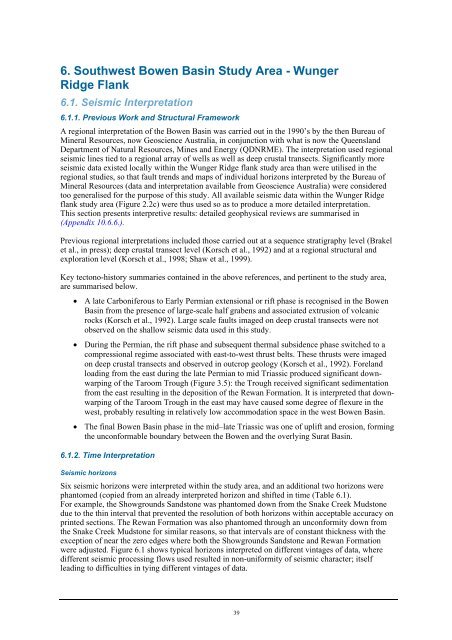
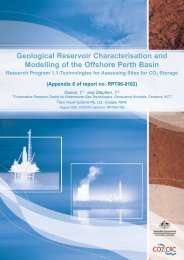
![Post-combustion solvent absorption [PDF 438KB] - CO2CRC](https://img.yumpu.com/48575763/1/184x260/post-combustion-solvent-absorption-pdf-438kb-co2crc.jpg?quality=85)

